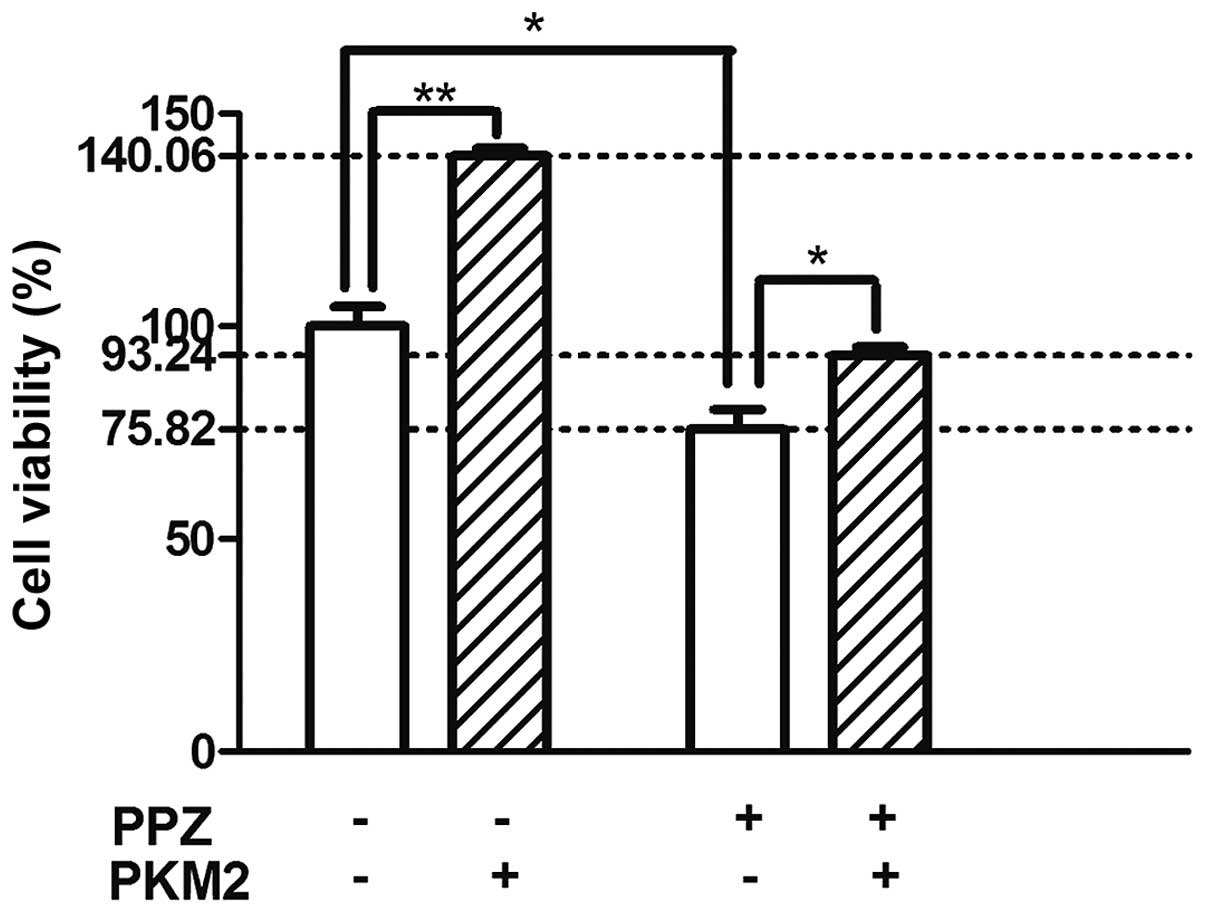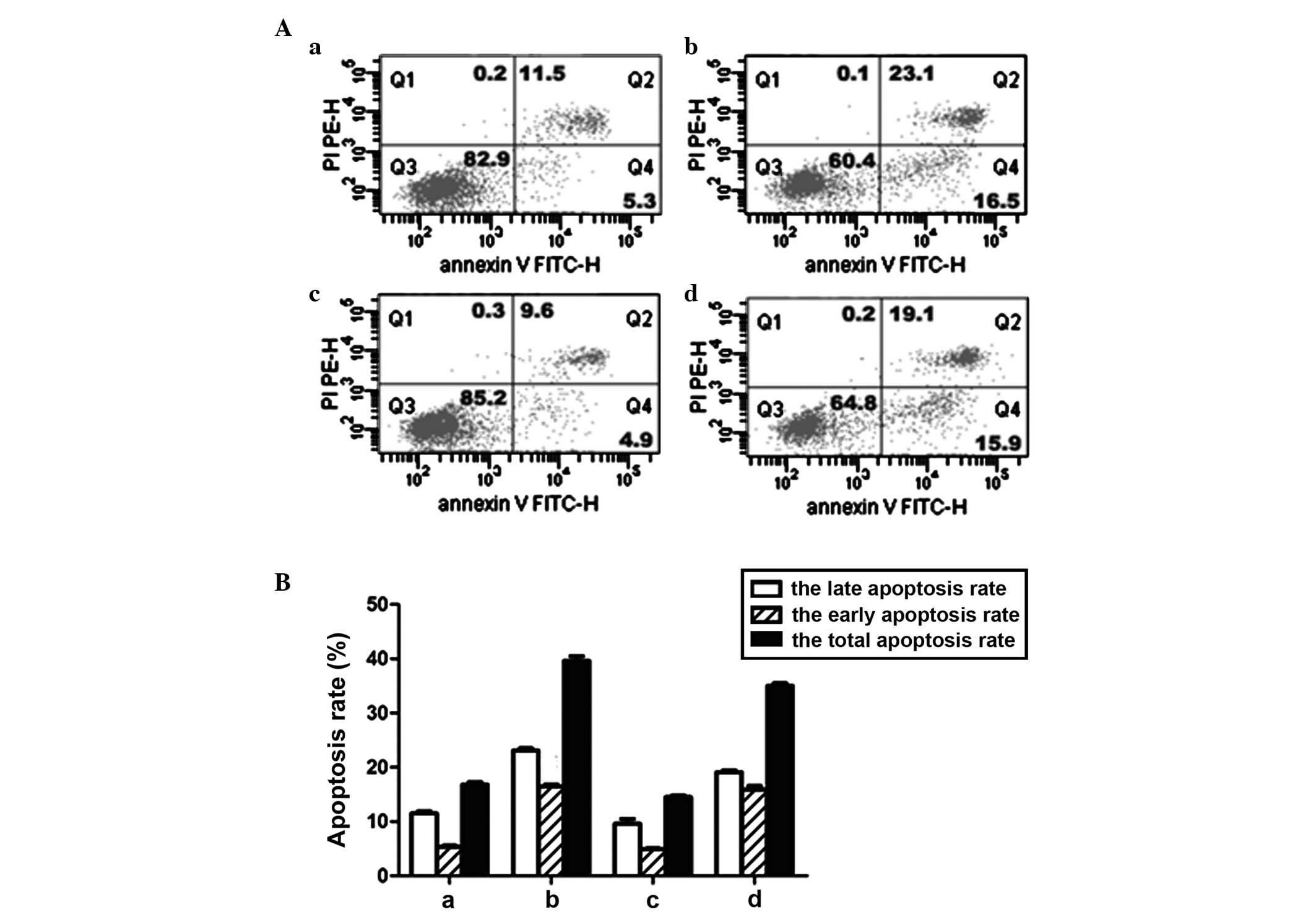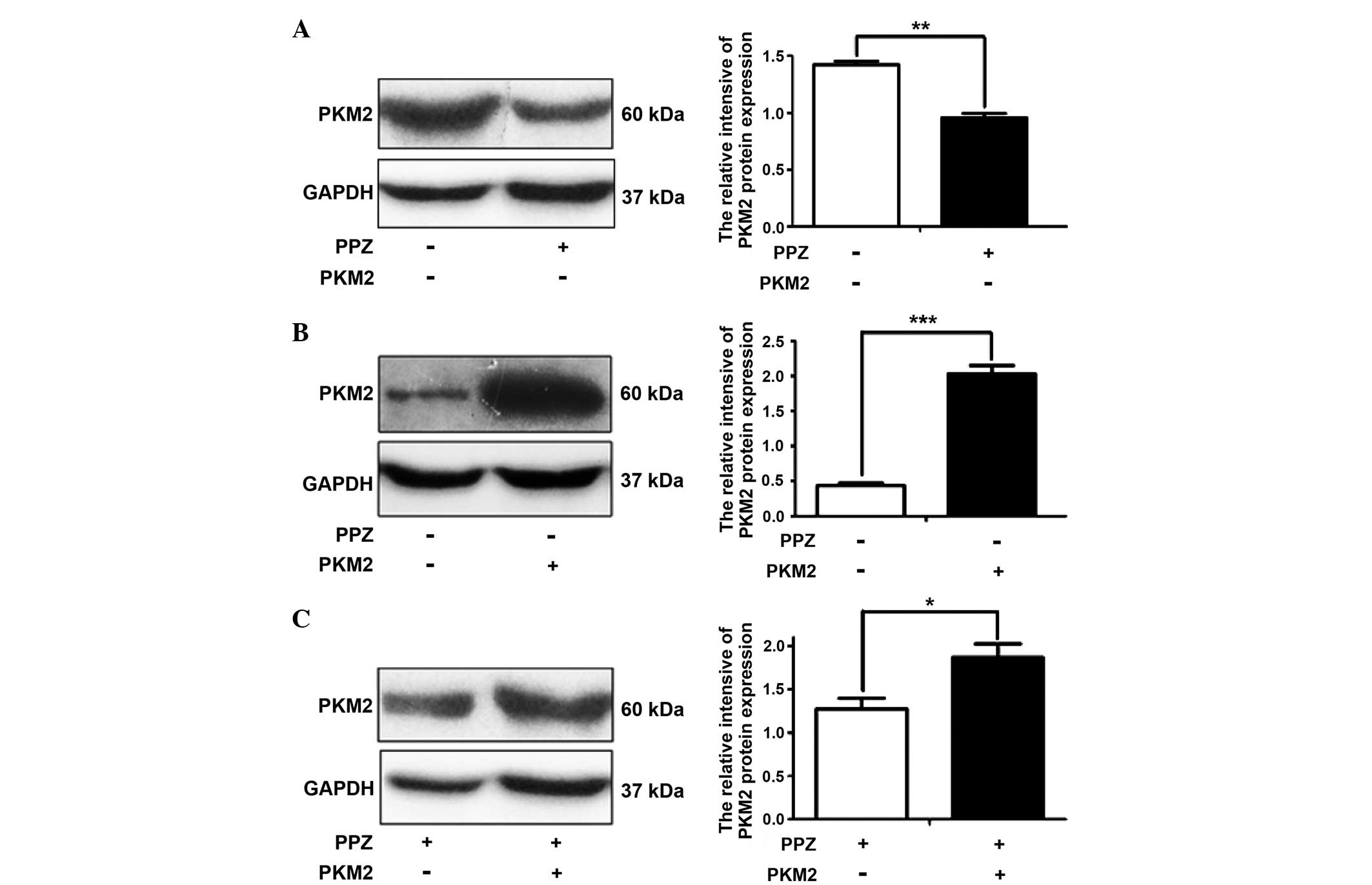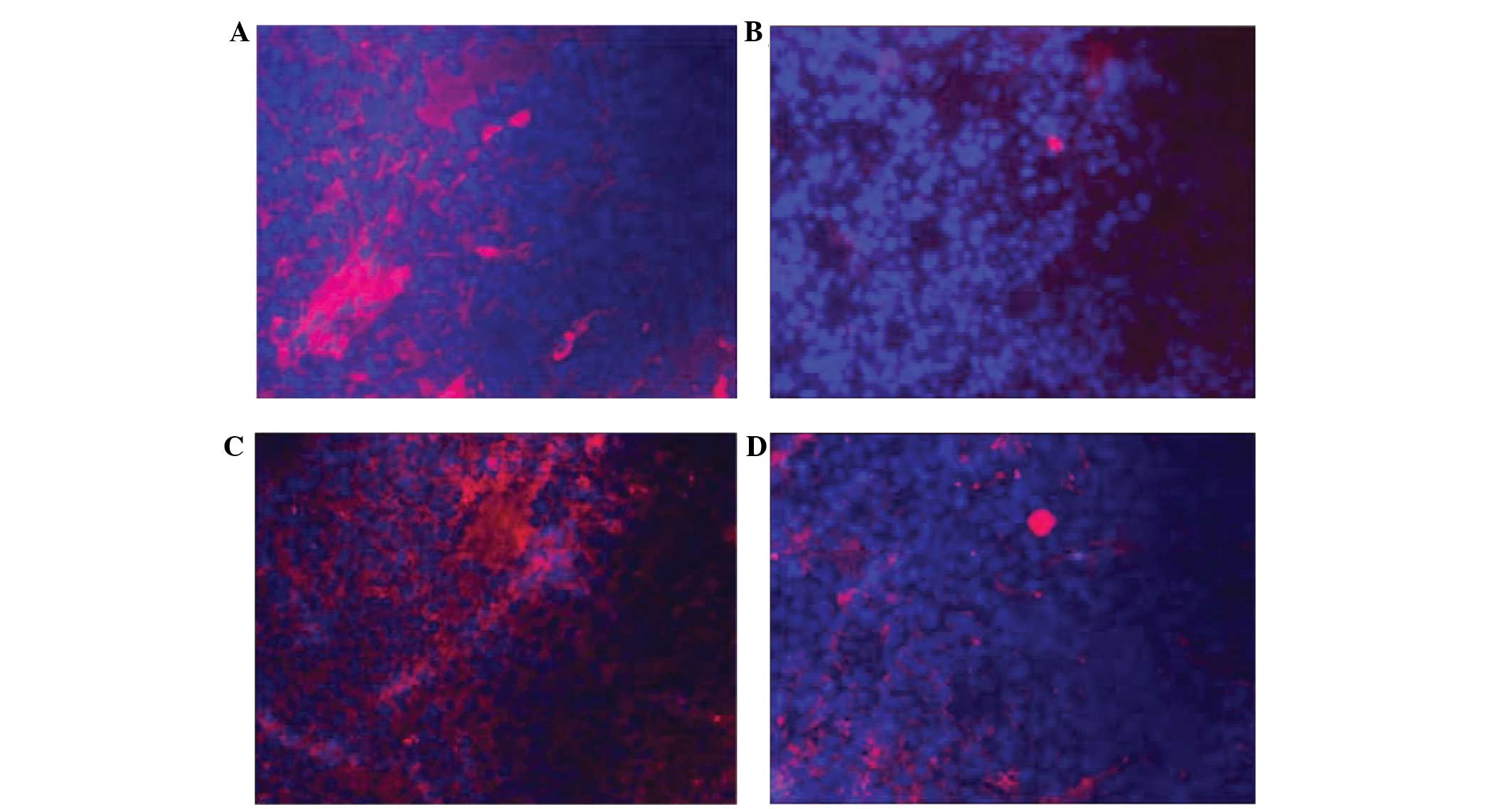Pantoprazole inhibits human gastric adenocarcinoma SGC-7901 cells by downregulating the expression of pyruvate kinase M2
- Authors:
- Published online on: November 13, 2015 https://doi.org/10.3892/ol.2015.3912
- Pages: 717-722
Abstract
Introduction
Aerobic glycolysis, first studied by Otto Warburg, is the process whereby tumor cells use glycolysis with reduced mitochondrial oxidative phosphorylation to metabolize glucose, even under aerobic conditions (1). The metabolic switch may be required to support cell growth more than the defects in mitochondrial respiration. In certain cancer cell lines, the most glycolytic tumor cells were demonstrated to also be the most aggressive cells (2). In another study, aerobic glycolysis was an essential step that ultimately resulted in tumorigenesis, which was characterized by enhanced activity of glycolytic enzymes and distinct changes in the glycolytic isoenzyme (3). There were three rate-limiting enzymes of glycolysis, consisting of hexokinase, phosphofructokinase and pyruvate kinase (4). Among these enzymes, pyruvate kinase catalyzed the final step of glycolysis, which is associated with the production of adenosine triphosphate and pyruvate, and was important during the process of glycolysis (5). Four pyruvate kinase isoenzymes are known in mammals: Liver-type pyruvate kinase (PKL) is expressed in the kidney and liver; protein kinase R (PKR) is expressed in red blood cells; the M1 isoform of pyruvate kinase (PKM1) is expressed in the majority of adult tissues; and the M2 isoform of pyruvate kinase (PKM2) is the embryonic form, and is a splice variant of PKM1 (6). PKM2 was overexpressed in numerous cancer cells. The expression of PKM2 was critical for rapid growth in cancer cells (7,8). However, inhibition of PKM2 may undesirably affect cancer cell metabolism (9–11).
Gastric cancer is one of the most common cancers, and is a leading cause of cancer-associated mortality in the world, accounting for ~8% of novel cancers (12). Numerous trials have demonstrated that PKM2 is overexpressed in gastric cancer and that the inhibition of PKM2 has well-supported anti-tumor effects (13–15). The critical role of PKM2 in gastric cancer suggests that identifying novel inhibitors of PKM2 may provide a promising future in the treatment of gastric cancer.
Proton pump inhibitors (PPIs) are highly effective in the treatment and symptomatic relief of peptic ulcers, by inhibiting H+,K+-adenosine triphosphate (ATP)ase in the gastric parietal cells (16). The effects of pantoprazole (PPZ), one type of PPI, on PKM2 were hypothesized to be associated with the inhibitory efficacy of PPZ (17,18). Yeo et al reported that PPZ selectively induced apoptotic cell death in in vivo and in vitro gastric cancer models (19), suggesting that PPIs may exert selective anticancer effects. However, there are few relevant studies, and the mechanisms involved remain unclear.
The present study aimed to determine whether PPZ inhibits proliferation and selectively induces apoptosis in SGC-7901 cells, possibly via a PKM2-mediated mechanism. The hypothesis was examined by altering the expression of PKM2 in vitro.
Materials and methods
Cell line and cell culture
The human gastric adenocarcinoma cell line SGC-7901 was kindly provided by the Department of Oncology, Medical School, Drum Tower Hospital of Nanjing University (Nanjing, Jiangsu, China). The cells were cultured in RPMI-1640 (Hyclone, Logan, UT, USA) supplemented with 10% fetal bovine serum (Hangzhou Sijiqing Biological Engineering Materials, Hangzhou, Zhejiang, China) and antibiotics (100 units/ml penicillin and 100 µg/ml streptomycin) in a humidified air with 5% CO2 at 37°C (Direct Heat CO2) (Thermo Fisher Scientific, Waltham, MA, USA).
Drugs and experimental design
Pantoprazole sodium salts (Takeda Pharmaceuticals International GmbH, Zurich, Switzerland) were resuspended in normal saline (0.85%) at 5 mg/ml immediately prior to use. When the SGC-7901 cells had reached 60–70% confluence, PPZ was added at a final concentration of 20 µg/ml, and the cells were cultured for additional experiments.
Transfection
The human gene encoding PKM2 was amplified using reverse transcription-polymerase chain reaction (RT-PCR) and the total-RNA extracted from the SGC-7901 cells. The PKM2 gene was ligated to an internal ribosome entry site (pIRES2)-enhanced green fluorescent protein (EGFP) plasmid (Invitrogen; Thermo Fisher Scientific) using T4 DNA ligase following digestion by the restricted endonucleases EcoRI and BamHI. SGC-7901 cells were transfected with the pIRES2-EGFP-PKM2 expression vector using Lipofectamine 2000 (Invitrogen; Thermo Fisher Scientific), according to the manufacturer's protocol for 24 h prior to PPZ treatment.
Cell proliferation assay
The SGC-7901 cells were seeded in 100 µl of medium per well, at a density of 1×104/well, in 96-well plates and treated with 5 mg/ml PPZ for 24 h. The cytotoxicity of PPZ was assessed by a cell counting kit-8 assay (KeyGen Biotech Co., Ltd., Nanjing, Jiangsu, China), according to the manufacturer's protocol. The cytotoxicity was expressed as the relative cell viability, using the following formula: Cell viability (%) = (OD of drug-treated sample / OD of untreated sample) × 100. The experiment was repeated 3 times.
Annexin V-fluorescein isothiocyanate (FITC) apoptosis detection
The SGC-7901 cells were seeded into 6-well plates. Following treatment with 5 mg/ml PPZ, the cells were trypsinized, washed twice with phosphate-buffered saline (PBS), resuspended and then stained with an Annexin V-FITC apoptosis detection kit (Nanjing KeyGen Biotech Co., Ltd.). The apoptosis of cells was analyzed using a flow cytometer (BD Biosciences, Franklin Lakes, NJ, USA). The experiment was repeated 3 times.
Western blot analysis
The expression of PKM2 was evaluated using western blot analysis. The cells were kept on ice for 30 min in lysate containing 0.01% phenylmethanesulfonylfluoride, 150 mM NaCl, 50 mM Tris-HCl, pH 8.0, 0.1% sodium dodecyl sulfate (SDS), 0.2% ethylenediaminetetraacetic acid, 1% Triton X-100 and 1% sodium deoxycholate, supplemented with the protease inhibitors leupeptin, aprotinin, phenylmethylsulfonyl fluoride and sodium orthovanadate (Roche Diagnostics, Basel, Switzerland). The lysed cells were then centrifuged at 9,660 × g at 4°C (Centrifuge 5804R; Eppendorf, Hamburg, Germany) for 15 min, leaving a supernatant of extracted proteins. The protein content was estimated according to the bicinchoninic acid protein assay kit (Nanjing KeyGen Biotech Co., Ltd.). In total, 50 µm of each protein sample was subjected to western blotting on a denaturing 10% SDS-polyacrylamide gel electrophoresis and then transferred to polyvinylidene fluoride membranes (Immobilon-P; EMD Millipore, Billerica, MA, USA) using a semidry transfer system (Bio-Rad Laboratories Inc., Hercules, CA, USA). The non-specific binding was blocked by the incubation of membranes in 1X Tris-buffered saline containing 0.05% Tween-20 with 5% nonfat dry milk for 1 h. Subsequently, the membranes were incubated overnight at 4°C with monoclonal rabbit antibodies against PKM2 (dilution, 1:1,000; no. 4053; Cell Signaling Technology Inc., Danvers, MA, USA, USA) and glyceraldehyde 3-phosphate dehydrogenase (dilution, 1:3,000; no. sc-51905; Santa Cruz Biotechnology, Inc., Dallas, TX, USA), which was used as an internal control for protein loading. Antibody binding was detected by incubating the blot with a horseradish peroxidase-conjugated goat anti-rabbit antibody (dilution, 1:1,000; KPL, Gaithersburg, MD, USA). The specific signals were visualized by enhanced chemiluminescence (Santa Cruz Biotechnology, Inc.). Digital images were obtained and analyzed by Quantity One V4.31 (Bio-Rad Laboratories, Inc.).
Immunofluorescence staining analysis
Dispersed cells were grown on glass slides within 6-well plates and were then treated with 5 mg/ml PPZ for 24 h. Subsequent to washing with PBS 3 times, the cells were fixed with cold acetone for 10 min at 4°C. Next, the cells were blocked with 10% normal goat serum (Wuhan Boster Biological Technology, Wuhan, China) for 30 min and probed with the antibody against PKM2 (dilution, 1:100) at 4°C overnight. Alexa Fluor dye-conjugated secondary antibodies (dilution, 1:100; Alexa Fluor 594) and 2 mg/ml goat anti-rabbit IgG (H + L) highly cross-adsorbed (Molecular Probes; Thermo Fisher Scientific) were incubated with the cells for 1 h to enable the samples to be visualized under a fluorescent microscope (Axio Imager A1; Carl Zeiss AG, Oberkochen, Germany). The nuclei were stained using Invitrogen 4′,6-diamidino-2-phenylindole (2 µg/ml; Thermo Fisher Scientific).
Statistical analysis
The data were analyzed using SPSS software, version 16.0 (SPSS Inc., Chicago, IL, USA) and the independent-samples t-test method. A P-value of <0.05 was considered to indicate a statistically significant difference.
Results
Effects of PPZ and PKM2 on cell proliferation
As demonstrated in Fig. 1, PPZ may inhibit the proliferation of the SGC-7901 cells. The cell viability in the PPZ+ group was significantly decreased compared with the PPZ− group (−24.18% vs. the PPZ− group; P<0.05). In addition, PKM2 transfection may notably increase cell viability (+40.06% vs. the PKM2− group; P<0.01). As expected, the cell viability in the PKM2+ group was increased compared with the viability in the PKM2− group subsequent to PPZ intervention (+17.42% vs. the PKM2− group; P<0.05).
Effect of PPZ and PKM2 on apoptosis in SGC-7901 cells
A quantitative analysis of the fluorescent signals was performed by fluorescence-activated cell sorting (FACS). The results were summarized in Fig. 2A and B. As exhibited in Fig. 2B, the early apoptosis, late apoptosis and total apoptosis rates in the PPZ+ group were notably increased compared with the PPZ− group (+1.2, +11.6 and +22.8%, respectively, vs. the PPZ− group; P<0.001). Following PKM2 transfection, the early and late apoptosis rates were not affected (P>0.05), while the total apoptosis rate was statistically decreased compared with the PKM2− group (−2.3% vs. the PKM2− group; P<0.05). Under PPZ intervention, there was no difference between the early apoptosis rates of the PKM2+ and PKM2− groups (P>0.05), while the apoptosis rate was decreased compared with the PKM2− group on the late apoptosis rate (−4.0% vs. the PKM2− group; P<0.01) and total apoptosis rate (−4.6% vs. the PKM2− group; P<0.05).
Effects of PPZ treatment and PKM2 transfection on protein expression of PKM2 in SGC-7901 cells
The expression of PKM2 in SGC-7901 cells was examined using western blot analysis. Following PPZ treatment without PKM2 transfection, the expression of PKM2 decreased when compared to that in the control group (P<0.01) (Fig. 3A). As Fig. 3B showed, the protein expression of PKM2 notably increased (P<0.001), which confirmed the success of PKM2 transfection. Furthermore, the PKM2 protein expression significantly increased following PKM2 transfection under PPZ treatment (P<0.05) (Fig. 3C).
PPZ intervention and PKM2 transfection affects the intracellular expression of PKM2
As an inhibitor of PKM2, PPZ treatment for 24 h caused decreased intracellular expression of PKM2 (Fig. 4A and B). Subsequent to PKM2 transfection, the fluorescent intensity of PKM2 expression significantly increased compared to the control group (Fig. 4A and C). In addition, the fluorescent intensity of the PKM2 expression in PKM2+ group with PPZ treatment was approximately the median (Fig. 4D).
Discussion
Although the Warburg effect was previously proposed, this phenomenon received sufficient attention after the successful application of positron emission tomography (PET) in the clinical diagnosis of tumors (20,21). In recent years, the therapeutic strategies aimed at the glycolytic pathway have been explored extensively; and as one of the key enzymes regulating aerobic glycolysis of tumor cells, PKM2 may be a potential target of cancer therapy. Christofk et al reported that PKM2 promoted the rapid growth of cancer cells by diverting glucose metabolites from energy production to anabolic processes, which was attributed to phosphotyrosine signaling regulation (8). Based on those results, targeting PKM2 may provide a novel method of reversing chemotherapy resistance to cancer therapy, by inhibiting tumor growth and promoting increased cancer cell apoptosis in vitro and in vivo (22). However, the role of PKM2 in tumor growth remains controversial. One study suggested that PKM2 was dispensable for tumor maintenance and growth in vivo, and considered that other metabolic pathways occurred in this complicated process (23). Therefore, to clarify the issue, the present study used the gastric adenocarcinoma SGC-7901 cell line with PPZ treatment and PKM2 transfection to observe cell proliferation and apoptosis, and simultaneously detect the protein expression of PKM2.
PPZ may suppress proliferation and induce apoptosis in SGC-7901 cells, which was also confirmed in a previous study (24). In the present study, it was observed that the expression of PKM2 decreased concurrently during this process. It is possible that decreased PKM2 expression impeded cancer cell growth, or the impeded cell growth reduced the protein expression of PKM2. In order to resolve this issue, the expression of PKM2 was increased using transfection, which demonstrated that cancer cell proliferation was elevated and apoptosis was restrained. Thus, it was concluded that PKM2 is crucial for cancer cell growth, to promote proliferation and to inhibit apoptosis. Based on this conclusion, the inhibition of PKM2 may elicit anticancer effects, which has been reported to involve various mechanisms, including the impairment of tumor growth, induction of apoptotic cell death and increased sensitivity to chemotherapy (7,11,25,26). In the present study, increased PKM2 expression by transfection may partially reverse the effects of PPZ in inhibiting cancer cell proliferation and inducing apoptosis. The cancer-specific metabolic transformation associated with therapeutic resistance is a promising target for cancer therapy (27,28). Response of the SGC-7901 cells was not observed subsequent to the inhibition of PKM2 by RNA interference or small-molecule inhibitors. An additional study may therefore be required.
The mechanisms underlying the effect of PPZ on the expression of PKM2 remain unclear. Tumor microenvironments are characterized by acidification and hypoxia. PPIs may inhibit the expression of vacuolar H+-ATPases (V-ATPases), which are important for maintaining an acidic extracellular pH (pHe) as specific proton pumps of the cell (24). A previous study demonstrated that PPZ treatment significantly inhibited protein expression of V-ATPases, mechanistic target of rapamycin (mTOR) and hypoxia-inducible factor 1α (HIF-1α), accompanied by increased pHe (29). Another study demonstrated that mTOR activation simulated hypoxic effects by inducing HIF-1α expression, which in turn enhanced PKM2 expression through collaboration with c-Myc-hnRNPs splicing regulators, leading to aerobic glycolysis in tumor cells (30). Therefore, PPZ may suppress SGC-7901 cancer cells by downregulating the V-ATPases/mTOR/HIF-1α/PKM2 signaling pathway. Alternatively, as benzimidazole compounds, which were found to regulate the stability of HIF-1α through the Hsp90-Akt pathway (31), PPZ may indirectly reduce the protein expression of PKM2 by inhibiting HIF-1α expression. Therefore, the inhibitory effects of PPZ on the PKM2 protein may involve a variety of factors.
In conclusion, PPZ was demonstrated to effectively inhibit PKM2 expression in human gastric adenocarcinoma SGC-7901 cells, which was associated with cancer cell proliferation and apoptosis. The present study has indicated a novel anticancer mechanism, thus extending the clinical utilization of PPIs as an anticancer drug by inhibiting the expression of PKM2 in gastric cancer cells.
Acknowledgements
The present study was supported by grants from Nanjing Medical Science and Technique Development Foundation (grant nos. 81101814, 81071816 and 81272742). This study was also supported by the Fundamental Research Funds for the Central Universities (grant no. 21414340154).
References
|
Warburg O: On the origin of cancer cells. Science. 123:309–314. 1956. View Article : Google Scholar : PubMed/NCBI | |
|
Simonnet H, Alazard N, Pfeiffer K, Gallou C, Béroud C, Demont J, Bouvier R, Schägger H and Godinot C: Low mitochondrial respiratory chain content correlates with tumor aggressiveness in renal cell carcinoma. Carcinogenesis. 23:759–768. 2002. View Article : Google Scholar : PubMed/NCBI | |
|
Jiang K, He B, Lai L, Chen Q, Liu Y, Guo Q and Wang Q: Cyclosporine A inhibits breast cancer cell growth by downregulating the expression of pyruvate kinase subtype M2. Int J Mol Med. 30:302–308. 2012.PubMed/NCBI | |
|
Furtado CM, Marcondes MC, Sola-Penna M, de Souza ML and Zancan P: Clotrimazole preferentially inhibits human breast cancer cell proliferation, viability and glycolysis. PLoS One. 7:e304622012. View Article : Google Scholar : PubMed/NCBI | |
|
Kosugi M, Ahmad R, Alam M, Uchida Y and Kufe D: MUC1-C oncoprotein regulates glycolysis and pyruvate kinase M2 activity in cancer cells. PLoS One. 6:e282342011. View Article : Google Scholar : PubMed/NCBI | |
|
Jurica MS, Mesecar A, Heath PJ, Shi W, Nowak T and Stoddard BL: The allosteric regulation of pyruvate kinase by fructose-1,6-bisphosphate. Structure. 6:195–210. 1998. View Article : Google Scholar : PubMed/NCBI | |
|
Christofk HR, Van der Heiden MG, Harris MH, Ramanathan A, Gerszten RE, Wei R, Fleming MD, Schreiber SL and Cantley LC: The M2 splice isoform of pyruvate kinase is important for cancer metabolism and tumour growth. Nature. 452:230–233. 2008. View Article : Google Scholar : PubMed/NCBI | |
|
Christofk HR, Van der Heiden MG, Wu N, Asara JM and Cantley LC: Pyruvate kinase M2 is a phosphotyrosine-binding protein. Nature. 452:181–186. 2008. View Article : Google Scholar : PubMed/NCBI | |
|
Yang W, Xia Y, Ji H, Zheng Y, Liang J, Huang W, Gao X, Aldape K and Lu Z: Nuclear PKM2 regulates β-catenin transactivation upon EGFR activation. Nature. 480:118–122. 2011. View Article : Google Scholar : PubMed/NCBI | |
|
Anastasiou D, Poulogiannis G, Asara JM, Boxer MB, Jiang JK, Shen M, Bellinger G, Sasaki AT, Locasale JW, Auld DS, et al: Inhibition of pyruvate kinase M2 by reactive oxygen species contributes to cellular antioxidant responses. Science. 334:1278–1283. 2011. View Article : Google Scholar : PubMed/NCBI | |
|
Goldberg MS and Sharp PA: Pyruvate kinase M2-specific siRNA induces apoptosis and tumor regression. J Exp Med. 209:217–224. 2012. View Article : Google Scholar : PubMed/NCBI | |
|
Jemal A, Bray F, Center MM, Ferlay J, Ward E and Forman D: Global cancer statistics. CA Cancer J Clin. 61:69–90. 2011. View Article : Google Scholar : PubMed/NCBI | |
|
Wang LY, Liu YP, Chen LG, Chen YL, Tan L, Liu JJ, Jazag A, Ren JL and Guleng B: Pyruvate kinase M2 plays a dual role on regulation of the EGF/EGFR signaling via E-cadherin-dependent manner in gastric cancer cells. PLoS One. 8:e675422013. View Article : Google Scholar : PubMed/NCBI | |
|
Lim JY, Yoon SO, Seol SY, Hong SW, Kim JW, Choi SH and Cho JY: Overexpression of the M2 isoform of pyruvate kinase is an adverse prognostic factor for signet ring cell gastric cancer. World J Gastroenterol. 18:4037–4043. 2012. View Article : Google Scholar : PubMed/NCBI | |
|
Kwon OH, Kang TW, Kim JH, Kim M, Noh SM, Song KS, Yoo HS, Kim WH, Xie Z, Pocalyko D, et al: Pyruvate kinase M2 promotes the growth of gastric cancer cells via regulation of Bcl-xL expression at transcriptional level. Biochem Biophys Res Commun. 423:38–44. 2012. View Article : Google Scholar : PubMed/NCBI | |
|
Blume H, Donath F, Warnke A and Schug BS: Pharmacokinetic drug interaction profiles of proton pump inhibitors. Drug Saf. 29:769–784. 2006. View Article : Google Scholar : PubMed/NCBI | |
|
Shen Y, Wu Y, Chen M, Shen W, Huang S, Zhang L and Zou X: Effects of pantoprazole as a HIF-1α inhibitor on human gastric adenocarcinoma sgc-7901 cells. Neoplasma. 59:142–149. 2012. View Article : Google Scholar : PubMed/NCBI | |
|
Tao T, Li G, Dong Q, Liu D, Liu C, Han D, Huang Y, Chen S, Xu B and Chen M: Loss of SNAIL inhibits cellular growth and metabolism through the miR-128-mediated RPS6KB1/HIF-1α/PKM2 signaling pathway in prostate cancer cells. Tumour Biol. 35:8543–8550. 2014. View Article : Google Scholar : PubMed/NCBI | |
|
Yeo M, Kim DK, Kim YB, Oh TY, Lee JE, Cho SW, Kim HC and Hahm KB: Selective induction of apoptosis with proton pump inhibitor in gastric cancer cells. Clin Cancer Res. 10:8687–8696. 2004. View Article : Google Scholar : PubMed/NCBI | |
|
Czernin J and Phelps ME: Positron emission tomography scanning: Current and future applications. Annu Rev Med. 53:89–112. 2002. View Article : Google Scholar : PubMed/NCBI | |
|
Gambhir SS: Molecular imaging of cancer with positron emission tomography. Nat Rev Cancer. 2:683–693. 2002. View Article : Google Scholar : PubMed/NCBI | |
|
Shi HS, Li D, Zhang J, Wang YS, Yang L, Zhang HL, Wang XH, Mu B, Wang W, Ma Y, et al: Silencing of pkm2 increases the efficacy of docetaxel in human lung cancer xenografts in mice. Cancer Sci. 101:1447–1453. 2010. View Article : Google Scholar : PubMed/NCBI | |
|
Cortés-Cros M, Hemmerlin C, Ferretti S, Zhang J, Gounarides JS, Yin H, Muller A, Haberkorn A, Chene P, Sellers WR and Hofmann F: M2 isoform of pyruvate kinase is dispensable for tumor maintenance and growth. Proc Natl Acad Sci USA. 110:489–494. 2013. View Article : Google Scholar : PubMed/NCBI | |
|
Chen M, Huang SL, Zhang XQ, Zhang B, Zhu H, Yang VW and Zou XP: Reversal effects of pantoprazole on multidrug resistance in human gastric adenocarcinoma cells by down-regulating the V-ATPases/mTOR/HIF-1α/P-gp and MRP1 signaling pathway in vitro and in vivo. J Cell Biochem. 113:2474–2487. 2012. View Article : Google Scholar : PubMed/NCBI | |
|
Spoden GA, Rostek U, Lechner S, Mitterberger M, Mazurek S and Zwerschke W: Pyruvate kinase isoenzyme M2 is a glycolytic sensor differentially regulating cell proliferation, cell size and apoptotic cell death dependent on glucose supply. Exp Cell Res. 315:2765–2774. 2009. View Article : Google Scholar : PubMed/NCBI | |
|
Guo W, Zhang Y, Chen T, Wang Y, Xue J, Zhang Y, Xiao W, Mo X and Lu Y: Efficacy of RNAi targeting of pyruvate kinase M2 combined with cisplatin in a lung cancer model. J Cancer Res Clin Oncol. 137:65–72. 2011. View Article : Google Scholar : PubMed/NCBI | |
|
Spoden GA, Mazurek S, Morandell D, Bacher N, Ausserlechner MJ, Jansen-Dürr P, Eigenbrodt E and Zwerschke W: Isotype-specific inhibitors of the glycolytic key regulator pyruvate kinase subtype M2 moderately decelerate tumor cell proliferation. Int J Cancer. 123:312–321. 2008. View Article : Google Scholar : PubMed/NCBI | |
|
Hamanaka RB and Chandel NS: Targeting glucose metabolism for cancer therapy. J Exp Med. 209:211–215. 2012. View Article : Google Scholar : PubMed/NCBI | |
|
Tamada M, Suematsu M and Saya H: Pyruvate kinase M2: Multiple faces for conferring benefits on cancer cells. Clin Cancer Res. 18:5554–5561. 2012. View Article : Google Scholar : PubMed/NCBI | |
|
Sun Q, Chen X, Ma J, Peng H, Wang F, Zha X, Wang Y, Jing Y, Yang H, Chen R, et al: Mammalian target of rapamycin up-regulation of pyruvate kinase isoenzyme type M2 is critical for aerobic glycolysis and tumor growth. Proc Natl Acad Sci USA. 108:4129–4134. 2011. View Article : Google Scholar : PubMed/NCBI | |
|
Won MS, Im N, Park S, Boovanahalli SK, Jin Y, Jin X, Chung KS, Kang M, Lee K, Park SK, et al: A novel benzimidazole analogue inhibits the hypoxia-inducible factor (HIF)-1 pathway. Biochem Biophys Res Commun. 385:16–21. 2009. View Article : Google Scholar : PubMed/NCBI |













